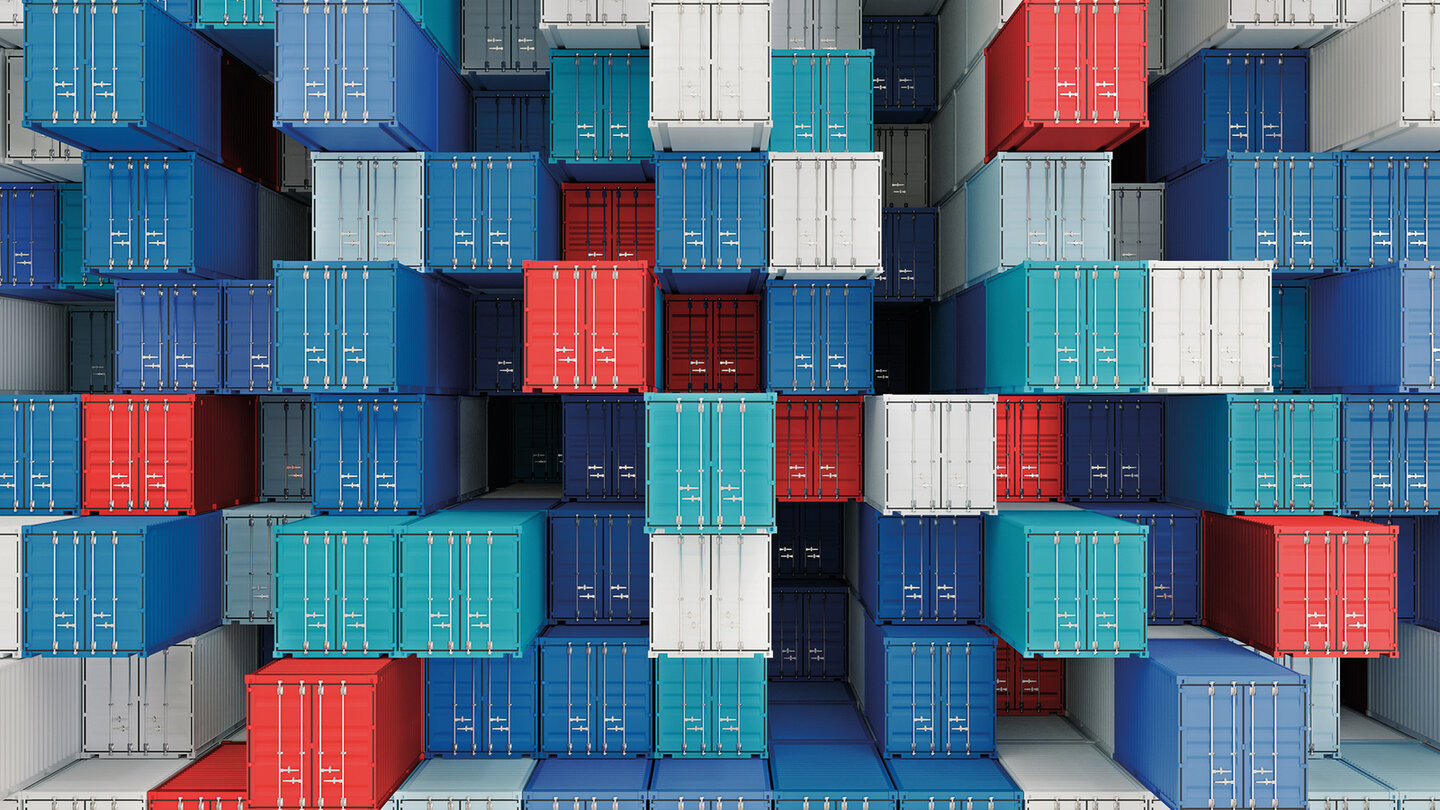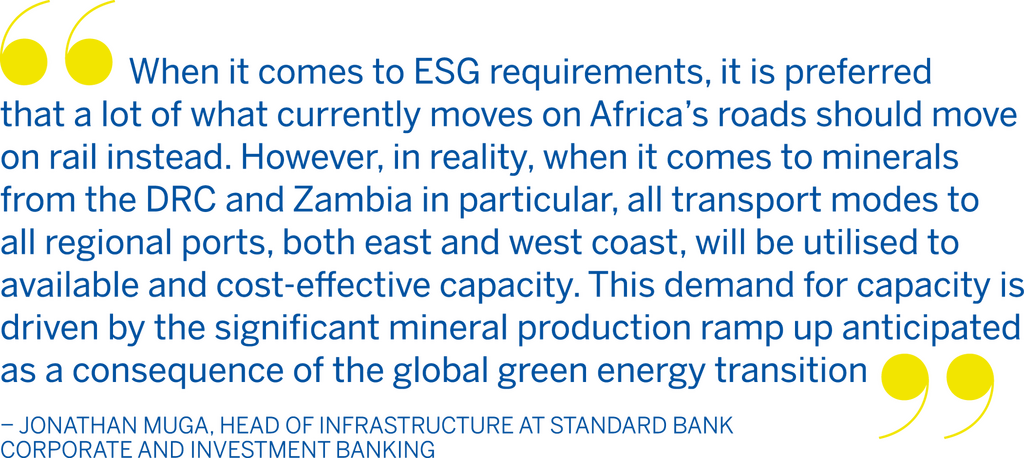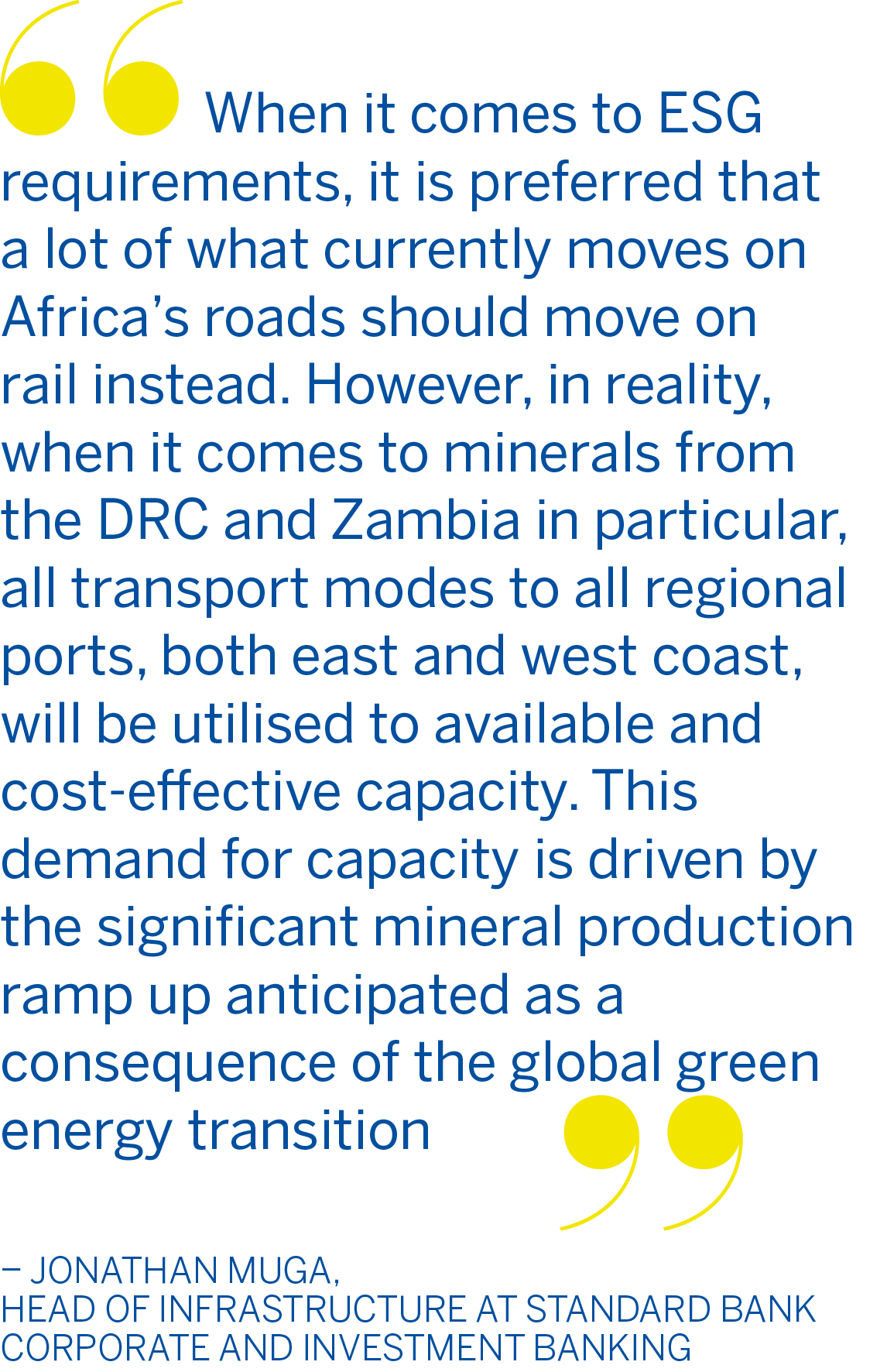
WE’LL GET THERE
read time 6min

Infrastructure
When it comes to Africa’s transport infrastructure, there’s always a bump in the road. Africa’s roads carry at least 80% of its goods and 90% of its passengers, according to the African Development Bank. However, according to the Center for Global Development, only 43% of the continent’s roads are paved and, again, 30% of its paved roads are in South Africa.
The continent boasts 84 000km of rail, but as the World Bank’s Africa Transport Policy Program points out, most of that network is located within 1 000km of the coast, and most of it is in either southern or northern Africa. According to The Economist, South Africa has about half of all the kilometres of rail in sub-Saharan Africa, yet in early 2023 state-owned logistics company Transnet announced plans to cut its loss-making 20 000km freight rail network by at least 35%. This presents opportunities for private sector rail operators to provide niche freight solutions on the unused Transnet infrastructure, by way of access agreements or public-private partnerships of some kind in the future.
ROAD TO RAIL
Add an environmental filter to those road and rail numbers, and an extra layer of “buts”, “yets” and “howevers” emerges. A 2021 study by Ghana’s Kwame Nkrumah University of Science and Technology found that only 41% of Rwandan vehicles and 25% of Ghanaian vehicles passed the national emission tests, while almost all diesel vehicles tested in both countries failed the United Kingdom emission test.

“Greenhouse gas emissions from transportation in Africa [are] growing at a rate of 7% annually,” wrote study lead Dr Godwin Ayetor. “Poor fuel quality, aging vehicle fleet, and lack of mandatory roadworthy emission tests were to blame for the deteriorating transport emissions.” The study also noted that more than 50% of African countries today have lower fuel quality than Europe had before 1992.
“When it comes to ESG requirements, it is preferred that a lot of what currently moves on Africa’s roads, especially when it comes to bulk commodities such as coal, iron ore, bauxite, manganese and chrome, should move on rail instead,” says Jonathan Muga, Head of Infrastructure at Standard Bank Group. “That is why we as a bank are pushing the road-to-rail theme where it is appropriate for heavy goods or commodity trade, and where there is uniformity of the rail gauge.”
The road-to-rail debate is not new, but Africa’s just energy transition now adds complexity and urgency to the conversation. The International Monetary Fund expects Africa’s population to double by 2050. “The future primary energy mix in the same timeframe shows that growth rates will be highest for renewable energy sources in absolute terms,” says Muga.
“Resources including copper, lithium, zinc, nickel, cobalt, manganese, rare earths, steel and aluminium are in high demand due to their significant role in emerging technologies such as electric vehicles, battery storage and renewable energy systems.”
That, he explains, is why public- and private-sector investors are looking at the cross-country corridors that move those critical minerals out of the continent, from resource-rich countries like Zambia and the Democratic Republic of Congo (DRC) to key outlets.
DRIVING DEMAND
Simulations by the Organisation for Economic
Co-operation and Development (OECD) found that improving Africa’s transport infrastructure could boost regional GDP growth by an extra 2.2% per year. But that goes both ways: the OECD also found that transport costs make up 30% to 40% of the final price for intra-African commodity trading.
For inland areas and landlocked countries like Rwanda and Burundi, those costs go even higher, reaching as much as 60%. So for every dollar spent on goods from Africa’s remote inland areas, you’re spending 60 cents just on the delivery costs.

Infrastructure is a prerequisite for the success of the African Continental Free Trade Area (AfCFTA). In its 2022 African Business Forum report, the United Nations Economic Commission for Africa warned that “inadequate transport infrastructure and services could hamper the full realisation of the benefits of [the AfCFTA]”.
Muga agrees. “Closing the gap is vital for economic prosperity, as improved infrastructure facilitates increased intra-regional and international trade,” he says. “The emphasis is on integrated logistics, combining ports, rail, roads, warehousing and vehicle assets to boost cross-continental and intra-African trade.”
The World Economic Forum expects the AfCFTA to drive a 28% increase in intra-African freight demand, which translates to additional demand for almost two million trucks, 100 000 rail wagons, 250 aircraft and more than 100 vessels by 2030.
Muga says the growing need for critical minerals offers an opportunity for collaboration among investors in mining, energy and logistics infrastructure to unlock transportation corridors for the broader benefit of the continent. In central and southern Africa, this includes key projects like the Lobito rail corridor, 337km dual carriage public-private partnership between the Zambian capital Lusaka and Ndola in the Copperbelt Province, Zimbabwe’s 940km cross-country road from Chirundu to Beitbridge, the 85km road and border post public-private partnership between Lumwana in Zambia and Kolwezi in the DRC, and more.
UNLOCKING EFFICIENCY
“A number of infrastructure projects are under way – both by governments and the private sector – to unlock commodity freight in Africa,” says Muga. “But for most of our clients, there are two big issues.”
One of these is the age-old logistics challenge of backhauling and empty wagons. “If you’re transporting goods in one direction, you want to transport other types of goods in the other direction,” he explains. “If you export chrome or copper to China, for example, you want those containers to come back filled with imported goods
from China.”
The other challenge is bottlenecking. “Trucks and
trains are getting stuck in queues at border posts
and ports,” Muga says.
East African Business Council CEO John Kalisa highlighted the problem of this non-tariff barrier to trade at the official opening of the AfCFTA Business Forum in Cape Town, South Africa, in April 2023. “As we say, goods move with people,” Kalisa said. “This idea of taking more than three days waiting for a visa application at the border is killing intra-African trade. As members of the Africa Business Council, we want African countries to eliminate visa applications at the border and reduce the amount of time it takes to fill in customs paperwork.”
The AfCFTA aims to solve these problems, turning the continent’s transport infrastructure narrative from one punctuated by “buts” and “howevers” into a story of “ands”. It’s one where transport corridors drive cargo from the continent’s resource-rich interior to its ports and border posts … and where those ports and border posts operate quickly and efficiently.
And ultimately, it’s one where Africa’s freight
rail networks take their carbon-emitting trucks off
the road and deliver the critical minerals that enable
the energy transition.
TEXT: Trevor Crighton
When it comes to Africa’s transport infrastructure, there’s always a bump in the road. Africa’s roads carry at least 80% of its goods and 90% of its passengers, according to the African Development Bank. However, according to the Center for Global Development, only 43% of the continent’s roads are paved and, again, 30% of its paved roads are in South Africa.
The continent boasts 84 000km of rail, but as the World Bank’s Africa Transport Policy Program points out, most of that network is located within 1 000km of the coast, and most of it is in either southern or northern Africa. According to The Economist, South Africa has about half of all the kilometres of rail in sub-Saharan Africa, yet in early 2023 state-owned logistics company Transnet announced plans to cut its loss-making 20 000km freight rail network by at least 35%. This presents opportunities for private sector rail operators to provide niche freight solutions on the unused Transnet infrastructure, by way of access agreements or public-private partnerships of some kind in the future.
ROAD TO RAIL
Add an environmental filter to those road and rail numbers, and an extra layer of “buts”, “yets” and “howevers” emerges. A 2021 study by Ghana’s Kwame Nkrumah University of Science and Technology found that only 41% of Rwandan vehicles and 25% of Ghanaian vehicles passed the national emission tests, while almost all diesel vehicles tested in both countries failed the United Kingdom emission test.

“Greenhouse gas emissions from transportation in Africa [are] growing at a rate of 7% annually,” wrote study lead Dr Godwin Ayetor. “Poor fuel quality, aging vehicle fleet, and lack of mandatory roadworthy emission tests were to blame for the deteriorating transport emissions.” The study also noted that more than 50% of African countries today have lower fuel quality than Europe had before 1992.
“When it comes to ESG requirements, it is preferred that a lot of what currently moves on Africa’s roads, especially when it comes to bulk commodities such as coal, iron ore, bauxite, manganese and chrome, should move on rail instead,” says Jonathan Muga, Head of Infrastructure at Standard Bank Group. “That is why we as a bank are pushing the road-to-rail theme where it is appropriate for heavy goods or commodity trade, and where there is uniformity of the rail gauge.”
The road-to-rail debate is not new, but Africa’s just energy transition now adds complexity and urgency to the conversation. The International Monetary Fund expects Africa’s population to double by 2050. “The future primary energy mix in the same timeframe shows that growth rates will be highest for renewable energy sources in absolute terms,” says Muga.
“Resources including copper, lithium, zinc, nickel, cobalt, manganese, rare earths, steel and aluminium are in high demand due to their significant role in emerging technologies such as electric vehicles, battery storage and renewable energy systems.”
That, he explains, is why public- and private-sector investors are looking at the cross-country corridors that move those critical minerals out of the continent, from resource-rich countries like Zambia and the Democratic Republic of Congo (DRC) to key outlets.
DRIVING DEMAND
Simulations by the Organisation for Economic Co-operation and Development (OECD) found that improving Africa’s transport infrastructure could boost regional GDP growth by an extra 2.2% per year. But that goes both ways: the OECD also found that transport costs make up 30% to 40% of the final price for intra-African commodity trading.
For inland areas and landlocked countries like Rwanda and Burundi, those costs go even higher, reaching as much as 60%. So for every dollar spent on goods from Africa’s remote inland areas, you’re spending 60 cents just on the delivery costs.

Infrastructure is a prerequisite for the success of the African Continental Free Trade Area (AfCFTA). In its 2022 African Business Forum report, the United Nations Economic Commission for Africa warned that “inadequate transport infrastructure and services could hamper the full realisation of the benefits of [the AfCFTA]”.
Muga agrees. “Closing the gap is vital for economic prosperity, as improved infrastructure facilitates increased intra-regional and international trade,” he says. “The emphasis is on integrated logistics, combining ports, rail, roads, warehousing and vehicle assets to boost cross-continental and intra-African trade.”
The World Economic Forum expects the AfCFTA to drive a 28% increase in intra-African freight demand, which translates to additional demand for almost two million trucks, 100 000 rail wagons, 250 aircraft and more than 100 vessels by 2030.
Muga says the growing need for critical minerals offers an opportunity for collaboration among investors in mining, energy and logistics infrastructure to unlock transportation corridors for the broader benefit of the continent. In central and southern Africa, this includes key projects like the Lobito rail corridor, 337km dual carriage public-private partnership between the Zambian capital Lusaka and Ndola in the Copperbelt Province, Zimbabwe’s 940km cross-country road from Chirundu to Beitbridge, the 85km road and border post public-private partnership between Lumwana in Zambia and Kolwezi in the DRC, and more.
UNLOCKING EFFICIENCY
“A number of infrastructure projects are under way – both by governments and the private sector – to unlock commodity freight in Africa,” says Muga. “But for most of our clients, there are two big issues.”
One of these is the age-old logistics challenge of backhauling and empty wagons. “If you’re transporting goods in one direction, you want to transport other types of goods in the other direction,” he explains. “If you export chrome or copper to China, for example, you want those containers to come back filled with imported goods from China.”
The other challenge is bottlenecking. “Trucks and trains are getting stuck in queues at border posts and ports,” Muga says.
East African Business Council CEO John Kalisa highlighted the problem of this non-tariff barrier to trade at the official opening of the AfCFTA Business Forum in Cape Town, South Africa, in April 2023. “As we say, goods move with people,” Kalisa said. “This idea of taking more than three days waiting for a visa application at the border is killing intra-African trade. As members of the Africa Business Council, we want African countries to eliminate visa applications at the border and reduce the amount of time it takes to fill in customs paperwork.”
The AfCFTA aims to solve these problems, turning the continent’s transport infrastructure narrative from one punctuated by “buts” and “howevers” into a story of “ands”. It’s one where transport corridors drive cargo from the continent’s resource-rich interior to its ports and border posts … and where those ports and border posts operate quickly and efficiently.
And ultimately, it’s one where Africa’s freight rail networks take their carbon-emitting trucks off the road and deliver the critical minerals that enable the energy transition.
TEXT: Trevor Crighton







